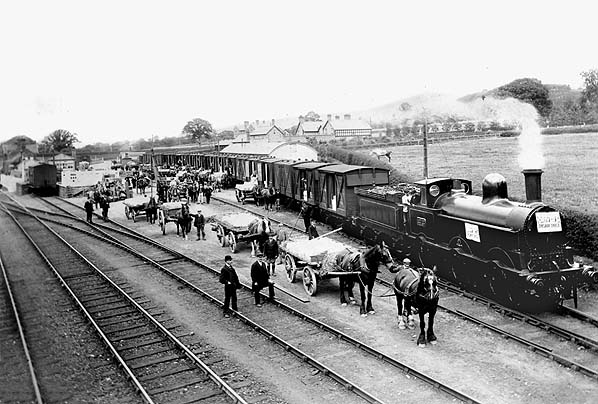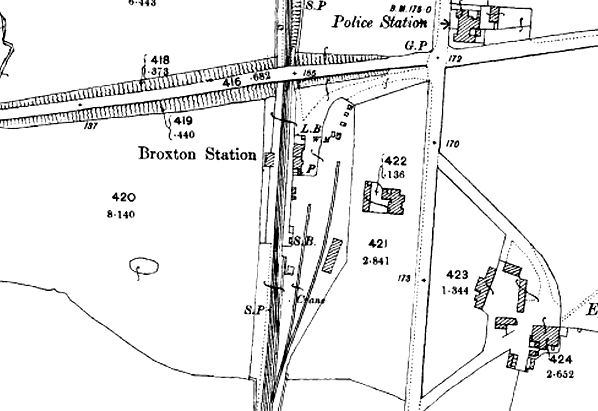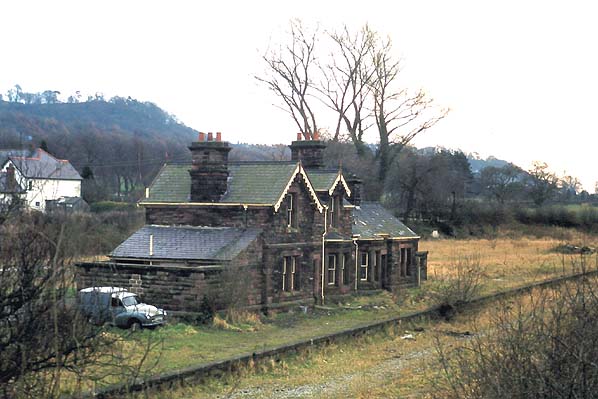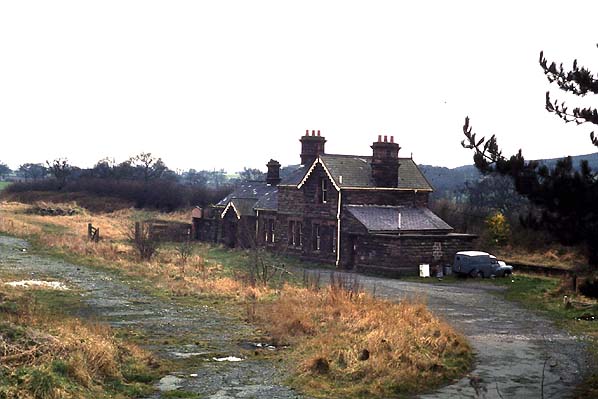
Station Name: BROXTON
|
| Date opened: | 1.10.1872 |
| Location: | South side of Broxton Road (A534) |
| Company on opening: | London & North Western Railway |
| Date closed to passengers: | 16.9.1957 |
| Date closed completely: | 4.11.1963 |
| Company on closing: | British Railways (London Midland Region) |
| Present state: | The station has been demolished and the site is now a public car park,. The base of the goods yard crane survives. |
| County: | Cheshire |
| OS Grid Ref: | SJ478543 |
| Date of visit: | 28.5.2006 |
Notes: Broxton station was located on the LNWR’s line that ran from a junction on the Crewe to Chester line, approximately two miles to the north of Tattenhall Village, to the market town of Whitchurch. The line was opened by the LNWR on 1st October 1872 and it was 14 miles in length and built to main line standards with double track throughout. It was intended to provide competition to the GWR route between Chester and Shrewsbury and the LNWR hoped that it would attract the majority of the coal traffic from South Wales which was destined for the Mersey Docks in Birkenhead. Some coal traffic did use the line, especially that originating from the Abergavenny - Merthyr line which was also under LNWR control .However most of the coal traffic bound for Birkenhead came from the North Wales coal fields around Wrexham which was GWR or GCR territory, this did not use the Whitchurch - Waverton line  Broxton station opened on the same day as the line and was sited some distance from any sizeable villages. It was provided with two platforms and a substantial sandstone station building on the southbound (Whitchurch) platform. The building provided booking facilities, waiting rooms and a two storey house for the stationmaster. On the southbound (Whitchurch) platform a simple timber waiting shelter with a canopy was provided. The road overbridge acted as the stations footbridge with steps down onto both platforms. Broxton station was also provided with a goods yard which was located to the south of the station on the east side of the line; a signalbox at the end of the southbound platform controlled access to the yard where the facilities included a cattle dock and a crane. Broxton station opened on the same day as the line and was sited some distance from any sizeable villages. It was provided with two platforms and a substantial sandstone station building on the southbound (Whitchurch) platform. The building provided booking facilities, waiting rooms and a two storey house for the stationmaster. On the southbound (Whitchurch) platform a simple timber waiting shelter with a canopy was provided. The road overbridge acted as the stations footbridge with steps down onto both platforms. Broxton station was also provided with a goods yard which was located to the south of the station on the east side of the line; a signalbox at the end of the southbound platform controlled access to the yard where the facilities included a cattle dock and a crane.
Broxton in particular benefited from the arrival of the railway and the station soon became the centre for transportation of fresh vegetables and fruit and livestock to places such as Manchester and Liverpool. Another important commodity was cheese; local cheese producers would bring their cheese to load on to trains bound for Whitchurch where there was an important cheese fair. A cheese warehouse was built to store cheese brought from a factory at Balderton near Chester. The cheese was was allowed to mature there prior to despatch.  Passenger train services were mostly of a local nature running between Chester and Whitchurch. Connections were possible to Liverpool and the area became popular with many businessmen who commuted by train. In 1922 there were seven daily trains in each direction, by 1950 this was reduced to five daily trains with an additional service on Wednesdays running through to Shrewsbury. There was never a Sunday service. Passenger train services were mostly of a local nature running between Chester and Whitchurch. Connections were possible to Liverpool and the area became popular with many businessmen who commuted by train. In 1922 there were seven daily trains in each direction, by 1950 this was reduced to five daily trains with an additional service on Wednesdays running through to Shrewsbury. There was never a Sunday service.Coal traffic from South Wales formed the bulk of early freight workings, probably passing over the branch at night en route for Birkenhead. Apart from competition from the GWR route from the Wrexham coalfield, there was also stiff competition from coastal shipping from the 1890’s and this traffic declined after the First World War.  The area through which the line passed is quite rural and because of this passenger numbers were never very large and never reached expectations although it did help Tattenhall's popularity as a commuter centre for nearby Chester. The branch declined rapidly after WW2 with more and more commuters abandoning railways in favour of more convenient road transport while an ever increasing amount of goods traffic switched over from cars to lorries. Passenger services were withdrawn from all the stations on the line on 16 September 1957, although the line remained open for freight traffic which continued to use the line mainly as a corridor, latterly with oil trains from the Stanlow refinery on the joint Hooton – Helsby line accessing the West Midlands without the need to use the GWR route over Gresford Bank. The last freight was an oil train from Stanlow to Rowley Regis in January 1963 but local goods traffic continued until 4 November 1963 with both Broxton and Malpas remaining open. The track was lifted in c.1965. The area through which the line passed is quite rural and because of this passenger numbers were never very large and never reached expectations although it did help Tattenhall's popularity as a commuter centre for nearby Chester. The branch declined rapidly after WW2 with more and more commuters abandoning railways in favour of more convenient road transport while an ever increasing amount of goods traffic switched over from cars to lorries. Passenger services were withdrawn from all the stations on the line on 16 September 1957, although the line remained open for freight traffic which continued to use the line mainly as a corridor, latterly with oil trains from the Stanlow refinery on the joint Hooton – Helsby line accessing the West Midlands without the need to use the GWR route over Gresford Bank. The last freight was an oil train from Stanlow to Rowley Regis in January 1963 but local goods traffic continued until 4 November 1963 with both Broxton and Malpas remaining open. The track was lifted in c.1965.Additional source: London & North Western Railway Society Journal September 2004 and Backtrack magazine March 2007, thanks to Tony Robinson for sending his text from these journals. Further reading: Down the Line by RM Bevan - A nostalgic journey along the old branch railway from Waverton (Chester) to Whitchurch, CC Publishing. Tickets from Michael Stewart To see other stations on the Waverton - Whitchurch line click on the station name: Whitchurch, Grindley Brook Halt, Malpas, Tattenhall & Waverton |

Reproduced with permission from 'Down The Line - A nostalgic journey along the old branch railway from Waverton to Whitchurch', by R.M.Bevan (www.cc-publishing.co.uk)


Broxton station shown on a 1899 map.
old1.jpg)
old2.jpg)
photo from John Mann collection

Broxton station looking south from the Broxton Road overbridge on 25 February 1973.
Photo by Keith Holt from the KDH Flickr photostream

Looking south-west at Broxton station on 25 February 1973. The driveway that linked it to Broxton Road is seen bottom right.
Photo by Keith Holt from the KDH Flickr photostream
2.jpg)
Photo by Paul Wright
 |
| Last updated: Sunday, 04-Jun-2017 10:04:20 CEST | © 1998-2013 Disused Stations |


thumb1.jpg)
 Home Page
Home Page